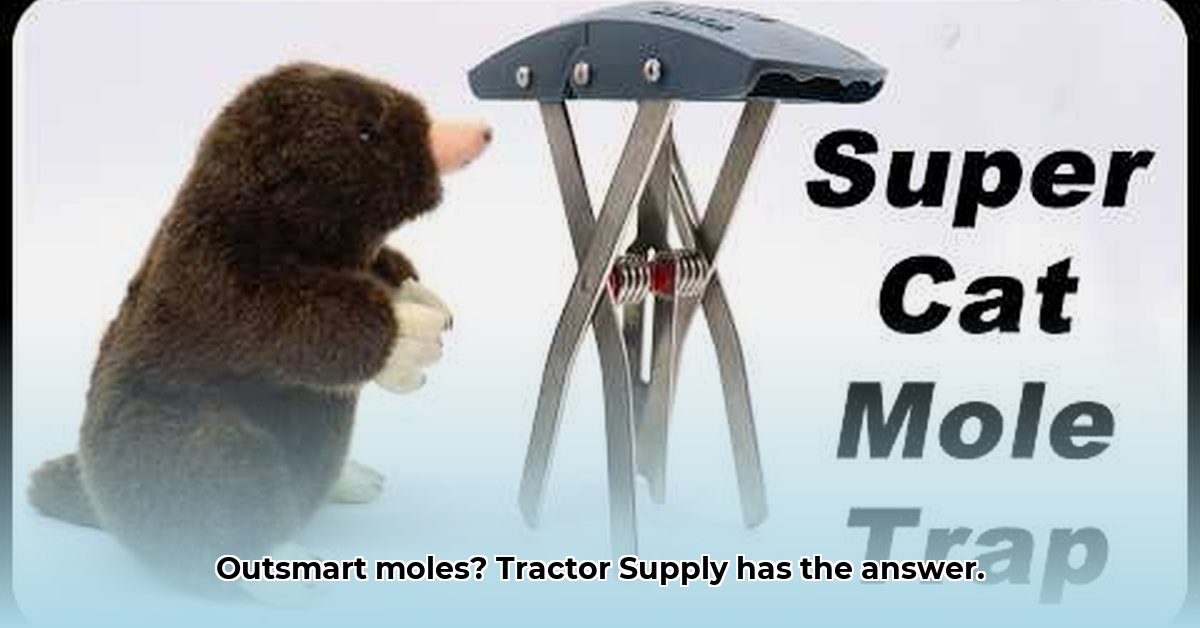
Moles disrupting your farm's productivity? Don't resort to harmful chemicals. This guide provides a practical, sustainable approach to mole control using traps readily available at Tractor Supply. We'll cover everything from identifying mole activity to choosing the right trap and implementing long-term preventative measures. Let's get started protecting your crops responsibly. For other helpful tools, check out Tractor Supply's other products.
Understanding Mole Activity and Damage
Before we delve into trapping, it's crucial to understand mole behavior and the damage they inflict. Moles are burrowing mammals that create extensive underground tunnel systems in search of earthworms and grubs. These tunnels can damage plant roots, disrupt irrigation systems, and create unsightly mounds on your land. Identifying fresh molehills—small mounds of freshly turned soil—is a clear sign of active tunneling. Have you noticed a significant increase in these mounds lately? This indicates ongoing activity and is the perfect trigger to implement a strategic solution.
Choosing the Right Mole Trap at Tractor Supply
Tractor Supply offers a range of mole traps, each suitable for different situations. Selecting the appropriate trap is key to successful and humane mole control. Let's examine three common types:
Scissor Traps: These traps use a scissor-like mechanism to quickly and humanely dispatch moles. They are generally highly effective but require precise placement within active tunnels.
Harpoon Traps: This style uses a spring-loaded spear to capture moles. Harpoon traps are often preferred in firmer soils but may require more skill in setting.
Choker Traps: These traps work by constricting the mole. They're often easier to set than scissor or harpoon traps but might require more frequent checks.
Here's how to make the right choice:
| Trap Type | Soil Type | Effectiveness | Ease of Use | Ideal Scenario |
|---|---|---|---|---|
| Scissor Trap | Most soil types | High | Moderate | Active tunnels in various soil conditions |
| Harpoon Trap | Firm, clay, or compacted soil | High | Difficult | Firm, well-drained soils, experienced users |
| Choker Trap | Loose, sandy soil | Moderate | Easy | Loose soils, beginners |
Remember, always refer to the specific instructions provided with your chosen Tractor Supply trap.
Setting and Using Your Mole Trap: A Step-by-Step Guide
Effective mole trapping requires precision and attention to detail. Follow these steps for optimal results:
Locate Active Runways: Identify fresh molehills, marking active tunnels. Look for areas with recent soil disturbance.
Prepare the Trap: Carefully read and follow the manufacturer's instructions for your specific trap model. Proper setup is critical.
Strategic Placement: Insert the trap directly into the active runway, ensuring the trigger mechanism is correctly aligned.
Concealment: Gently cover the trap with soil, camouflaging it seamlessly. A natural appearance increases capture success rates.
Regular Monitoring: Check your traps daily. Remove captured moles humanely and dispose of them according to local guidelines. Consistent monitoring is crucial for effectiveness.
Beyond Trapping: Sustainable Mole Prevention
While trapping addresses immediate problems, preventing future infestations is equally important. Employ these preventative measures:
Improve Drainage: Well-drained soil is less attractive to moles. Address any areas with poor drainage.
Maintain a Healthy Lawn: A thick, healthy lawn can make it harder for moles to create tunnels.
Reduce Grub Populations: Moles feed on grubs. Consider strategies to reduce their numbers—but always opt for environmentally friendly methods.
Safety and Environmental Considerations
Always prioritize safety! Wear gloves when handling traps. Dispose of captured moles and used traps responsibly, adhering to local environmental regulations. Remember, sustainable pest control is about minimizing harm to the environment.
Conclusion: Reclaiming Your Land Sustainably
By combining strategic trapping with preventative measures, you can effectively manage mole infestations sustainably. Tractor Supply offers effective tools; responsible use and an understanding of mole behavior maximize your success. Remember, consistent monitoring and appropriate trap selection are key to maintaining a healthy and productive field.